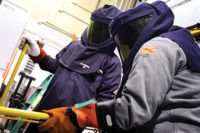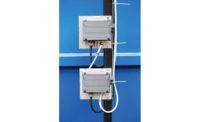OSHA is citing and fining employers for failure to protect employees from the dangers of arc flash. For guidelines on how to protect employees, OSHA refers employers to the NFPA 70E standard, “Standard for Electrical Safety in the Workplace.”
This document provides information on the most current arc flash labeling requirements, as well as best practices for creating and maintaining such labels. In the 2015 version of the NFPA 70E standard, arc flash labeling requirements are covered under Article 130.5(D) and 130.7(E)(1). Additional labeling requirements are also included in Article 110.16 of the 2014 version of the National Electric Code (NEC).
What needs to be labeled?
Arc flash labeling is the responsibility of the employer, not the manufacturer or installer of the equipment. The NEC provides the following examples of electrical equipment that must be field marked with a warning label. This is not an all-inclusive list: switchboards, panel boards, motor control, industrial control and meter socket.
Labeling is required for any piece of electrical equipment that is likely to require examination, adjustment, service or maintenance while energized, creating the potential for an arc flash incident to occur. Thus, many employers are also labeling bus ducts and other electrical equipment not specifically called out in the NEC.
Any modifications or renovations to electrical equipment that will change data on the label will require an updated arc flash risk assessment and label according to the 2015 NFPA 70E standard. At minimum, the safety program needs to be audited at intervals not to exceed three years and arc flash risk assessment shall be periodically reviewed at intervals not to exceed five years. The labeling requirements for equipment installed prior to the 2002 NEC Provision are not specifically stated. However, OSHA’s General Duty Clause for hazard warning may apply here. Should the equipment be modified or upgraded in any way, then a label must be affixed. In fact, an OSHA representative has stated that even changing a fuse or circuit breaker could be considered a modification that would require labeling. Labels applied prior to September 30, 2011 are acceptable if they contain the available incident energy or required level of PPE.
From a safety perspective, the hazard is the same regardless of when the equipment was installed. Consequently, most employers are simply labeling all the appropriate equipment, regardless of when it was installed.
The NEC requirement states that the marking must be in a location that is clearly visible to qualified persons before they begin work. Typically, the label is placed outside the panel or enclosure door. In some cases, companies choose to put the label inside the door to protect it from harsh environments; however, this should only be done if the door must be opened (allowing the label to be seen) in order to remove the panel face or enclosure. The key point is that the label should be easily noticeable by workers before they may be exposed to any potentially dangerous live parts.
What needs to appear on the label?
Article 110.16 in the NEC states that relevant electrical equipment shall be “field marked to warn qualified persons of potential electric arc flash hazards.”
In Article 130.7(E)(1), the NFPA 70E standard further notes that the design and formatting of the labels should conform with ANSI Z535 Series of Standards For Safety Signs & Tags. Thus it is recommended that the header, message and pictogram, if used, be formatted according to ANSI standards. Currently there is not a widely-accepted symbol for indicating an arc flash hazard.
Neither the NFPA 70E nor the NEC requirements specify whether to use a “Danger” or “Warning” header; however, NFPA 70E does recommend identifying those situations in which there is a hazard to the worker. A commonly used guideline is to use a red “Danger” header when the voltage is over 600 volts or when the incident energy is over 40 cals/cm2.
It is also important to note that arc flash labels must be able to withstand their usage environment. This means that the print should not fade and the adhesive should be aggressive enough to avoid peeling. When necessary, an overlaminate should be applied to protect the printed surface from harsh chemicals and exposure to sunlight.
Once an arc flash risk assessment has been conducted, in which the arc flash boundary, the incident energy at the working distance and the personal protective equipment required has been determined, Article 130.5 (C) in the 2015 edition of NFPA 70E further dictates that the label must contain these important elements:
1. Nominal system voltage
A value assigned to a circuit or system for the purpose of conveniently designating its voltage class (e.g. 120/240 volts, 480/277 volts, 600 volts).
2. Arc flash boundary
The distance at which an electrical arc can flash outward, which may endanger employees working on electrical equipment, where up to second degree burns are likely to occur.
3. At least one of the following:
a. Available incident energy and the corresponding working distance (An incidental energy analysis is used to help predict the incident energy of an arc flash for a specified set of conditions. Incident energy is the amount of energy impressed on a surface, a certain distance away from the source, generated during an electrical arc event. This should be measured and labeled in cal/cm2). Or the arc flash PPE category in Table 130.7(C)(15)(A) (b) or 130.7(C)(B) for equipment. But not both, or
b. Minimum arc rating of clothing (This also should be expressed in cal/cm2. Arc rated clothing indicates it has been tested for exposure to an electrical arc.This was formally expressed as flame resistant in previous NFPA editions), or
c. Site-specific level of PPE.
Know your hazards
With the rising frequency of reported arc flash accidents, and the potential for serious injury or death, arc flash deserves the concern it is generating within OSHA and the safety industry.
To increase safety and ensure compliance throughout the workplace, it is essential to learn and identify arc flash hazards in your facilities. Train your employees in safe work practices and utilize the labels and awareness aids that are available to you to keep the message in the forefront of your workers’ minds, and reinforce the desired behavior in your own facility.






